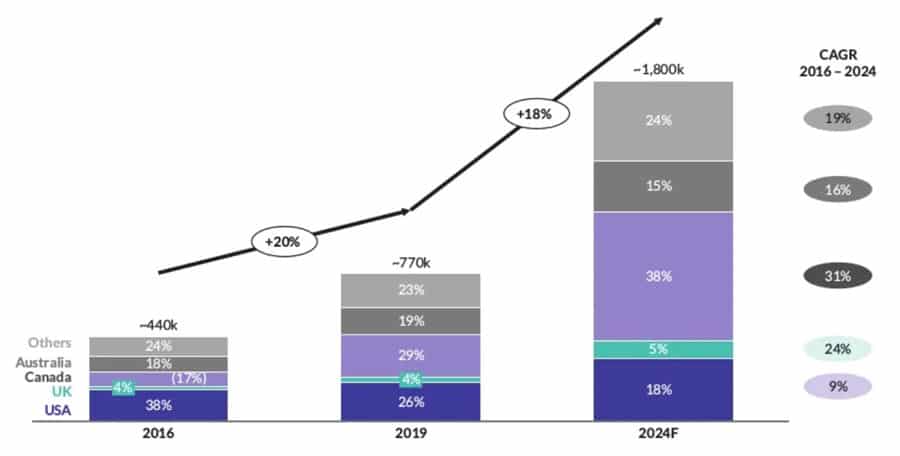Forecast projects 1.8 million Indian students abroad by 2024
- The importance of the Indian market as a major driver of global growth in student mobility is on display in a recent analysis
- It projects that Indian outbound will more than double over the next few years to reach 1.8 million students by 2024
- Total student spending is expected to exceed US$75 billion by that point
A 2021 analysis from RedSeer Strategy Consultants tracks the rapid growth in Indian outbound through 2019, at which point there were nearly 800,000 students studying abroad.
That total is projected to more than double again by 2024 to reach up to 1.8 million outbound students with total spending forecast at between US$75-US$85 billion by that point (a spending outlook that reflects anticipated inflation in tuition fees as well as living expenses).
This further surge in Indian numbers comes on top of a period of significant growth leading up to the start of the COVID-19 pandemic, such that India quickly became a top sender for leading destinations, notably Canada, the US, Australia, and the UK.
Those countries will remain among the top choices for Indian students going forward, but observers expect larger volumes to flow to a wider range of host countries as well, including Germany, Italy, China, Russia, Turkey, and Ireland.

What is driving those growth projections?
There are a number of factors that will continue to drive rapid growth in Indian outbound, especially the massive demand in the country for quality higher education programmes.
There are two important drivers of that demand: on the one hand, students associate higher education institutions in those leading destinations with better educational quality and outcomes. On the other, there remain substantial supply-side gaps in the Indian higher education system such that there simply aren't enough spaces available at quality institutions to meet the burgeoning demand from Indian families.
Alongside is the increasing capacity of Indian families to fund studies abroad. "There has been a massive increase in incomes in India over the past two decades," says RedSeer. "That has translated into a growing spend on post K-12 education. Additionally, the populace is becoming more aware of the benefits of studying abroad and Indians have a rising diaspora in popular destination countries which is stoking applications abroad and student outflows."
A more complex and nuanced marketplace
The Indian market's affinity for English-speaking destinations derives in part from the prevalence and day-to-day use of English within India, but also to the large and impactful Indian diaspora in most major study destinations.
"Students from States like Andhra Pradesh, Punjab, and Maharashtra have migrated abroad over a long period and have established communities in the top destination countries," adds the report. "They are also more aware of the processes for obtaining permanent residency in the countries and have access to better job opportunities as placements abroad are typically driven through networks rather than institutions."
And while there is no doubt that opportunities to work during and after studies are major drivers for Indian students, RedSeer notes as well the emergence in recent years of an "'Experience-seeking' student cohort…who are typically concentrated at an undergraduate level or non-STEM disciplines. These students generally belong to high-income households and are relatively less concerned with immediate work opportunities."
In a similar vein, an August 2022 report from the Institute of International Education (IIE) and the IC3 Institute adds that, "There has also been a paradigm shift in the demographics of Indian students who aspire to study abroad. In recent years, smaller towns and cities such as Vijaywada, Warangal, and Tirupati, known as Tier 2 and Tier 3 cities, are the points of origin yielding large numbers of prospective Indian students wishing to study overseas. There is a huge appetite for high-quality international education and a desire for international employability and mobility. This trend is likely to continue as the youth bulge in India continues to grow, not just in the capital cities but across the country."
For additional background, please see:
















